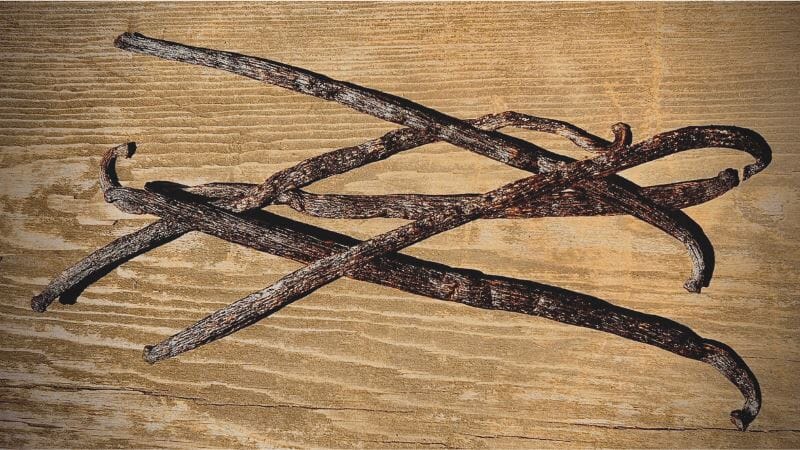Can You Grown Your Own Vanilla?
As is the case with many ingredients, the answer to the question, “can I grow my own” can be answered most accurately with, “it depends”. You see, vanilla beans come from a plant, so with the proper research and conditions, you will most likely be able to grow your own.
That said, vanilla beans fetch such a steep price for good reason—the plant they come from requires a very specific environment, lengthy growth times, hands-on cultivation, and ripening and curing times that together take about a year. From start to finish, it might be as many as 5 years before you know if you were successful at your vanilla growing endeavor.
What you should know before attempting to grow your own vanilla beans:
There are many things you should consider before diving into growing your own vanilla, so to get you started with your research, we’ve summarized some of the most important things you should first be aware of.
What is a vanilla bean plant?
Vanilla beans are the fruit of a vining, tropical orchid plant. With this newfound knowledge, you might be surprised to learn that there are no other orchids that produce edible fruit. That said, there are different varieties of the vanilla orchid that produce beans with a wide array of flavor and aroma profiles.
Botanically speaking, all vanilla bean plants are considered to be semi-epiphytic —meaning they can be grown in soil or as air plants, given the right conditions. Even when grown in soil, they will develop additional “air roots”, which will pull moisture from the air. They are perennials, so with the right care, they will not die off each year as is the case with annual plants.
How long does it take to get vanilla beans from vanilla orchids?
If you want to grow and harvest your own vanilla beans, you need to practice extreme patience. Best case scenario, you purchase pre-potted and established plants that have already reached maturity, but even if this is the case, they will only bloom once a year.
The other options are to obtain rooted cuttings or snipping and rooting plants yourself. In these instances, once they have successfully rooted, the plants will take anywhere from 2 to 4 years to reach maturity.
How do you care for vanilla orchid plants?
Patience isn’t the only trait you’ll need to put into practice in order to successfully give rise to beans from your vanilla orchid. You will also need to be incredibly diligent in ensuring the soil properties, temperature, and moisture levels are just right. The optimal conditions for growing vanilla orchids are as follows:
- High humidity levels
- Bright, but not direct light
- Well drained, acidic soil
- Warm temperatures of about 85°F during the day and cooling off by about 20 degrees in the evening.
Vanilla orchids are incredibly finicky. They do like plenty of moisture, but there is a fine line between ample and too much. If they get too wet, or do not have proper drainage, root rot and mold may become problems.
Unless you live in a tropical climate, your best bet for recreating the preferred conditions of vanilla orchids is to grow them in a greenhouse, with trellising of sorts for the vines to grow on. Having an environment that can be more easily controlled will allow you to ensure your plants are only exposed to indirect sunlight, with temperature and moisture at the appropriate levels, and proper drainage and growing room.
How do you get vanilla orchids to fruit?
If you are trying to grow vanilla anywhere outside of the plant’s native region, you will need to hand-pollinate the flowers to produce fruit. The first thing to consider when setting out to hand-pollinate vanilla orchids is timing. Vanilla orchids bloom only a single time each year, with the flowers remaining open for less than 24 hours—opening in the early morning and closing in the afternoon.
This small window of time is your only opportunity to pollinate your flower, so you have to keep a watchful eye over your orchid plants if you don’t want to miss your chance. When the flower does open, you will need to locate the reproductive part of the plant, use a small object (like a toothpick or something similar) to pull back the flap of the pistil, and carefully press the pollen-containing stamen down against it. If the plant has been successfully pollinated, you will soon notice the base of the flower will begin to plump up. In about 9 months, if all goes well, you should have a ripe vanilla bean.
Other considerations for producing your own vanilla beans:
Let’s say you have successfully gotten a vanilla plant to bloom, hand-pollinated it in time, and have made it through the nine months it takes for the bean to develop to maturity and ripen. Congratulations is definitely in order, but your vanilla bean is far from ready. You will next need to cure the bean.
Curing vanilla beans is an incredibly laborious process and one that takes months. There are several different methods of doing this, but all consist of the same basic steps: heating to kill and begin the browning process, either with sun or hot water; sweating to allow the plant achieve optimum sweetness and vanillin content; drying; and conditioning.
*****
Shop Our Gourmet Grade-A & Grade-B Vanilla Beans
We hope you have found this introduction to growing vanilla beans helpful.
As you can see, there are many factors that position vanilla beans as the second most expensive spice. If you choose to grow your own vanilla beans, we do suggest doing further research, as this is meant to be merely an introduction. Once you have done that and are ready to embark on a vanilla growing journey, we wish you the best of luck in your endeavor.
If, on the other hand, you feel like you don’t have the time to put into these incredible plants, there are plenty of world-class vanilla beans available for purchase on our online spice shop.







Slofoodgroup
Author